
Jaw misalignment
Jaw misalignment has a severe impact on the facial profile. The correction of misaligned jaws helps to harmonize the facial features.
Correction of jaw misalignment (dysgnathia)
Dysgnathia (from Greek gnathos = jaw), also referred to as incorrect bite, is defined as an incorrect jaw-to-jaw relationship between the maxilla and mandible or a misalignment of the jaws and facial skull. Dysgnathia may be genetically inherited or caused by oral habits.
The severity of jaw misalignment may vary and thus cause many different disorders. Dysgnathia may produce dental stress and premature loss of teeth. Moreover, chronic overworking of the temporomandibular joint (TMJ) may create a symptom complex that may include slight TMJ pain, clicking or popping jaws or even severe headache and back pain. Many people with a receding upper jaw suffer from extreme snoring or even sleep apnoea. If jaw misalignment is significant, lip occlusion may be impaired. This will aggravate mouth breathing and increase susceptibility to dental caries. Caries is also a frequent consequence of dental crowding because crowding may prevent thorough cleaning of the teeth. Severe jaw misalignment may even make it difficult for patients to speak, bite and chew properly.
Considering the individual antatomy of each patient the planning is created virtual and three-dimensional.






Schematic course of a bignathen Umstellungosteotie of upper and lower jaw in a class II gearing (lower jaw too far back)
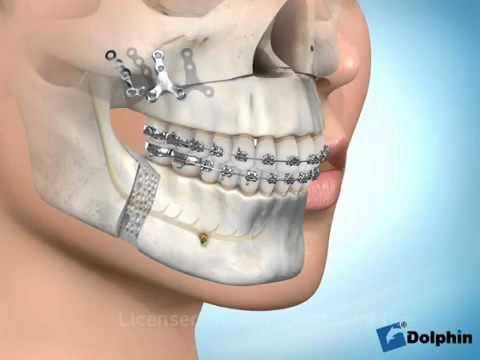
Schematic procedure of a bignathe Umsetzosteotomie of upper and lower jaw in a class III gearing (lower jaw too far forward)
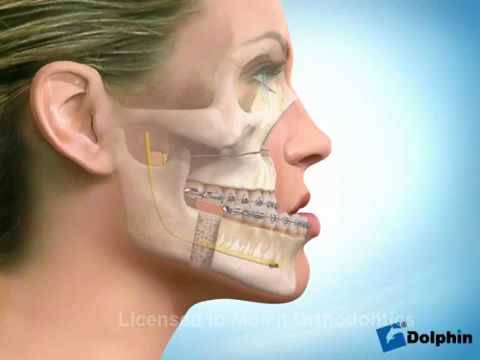
Schematic sequence of a surgical palatal dilatation with subsequent distraction
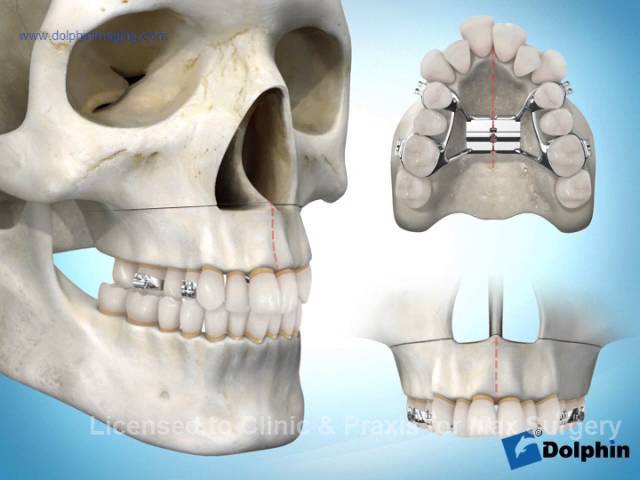
Example of an upper jaw advancement
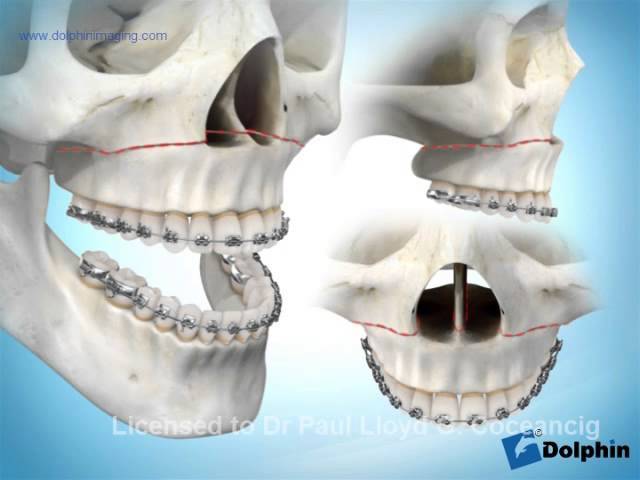
Example of a mandibular advancement
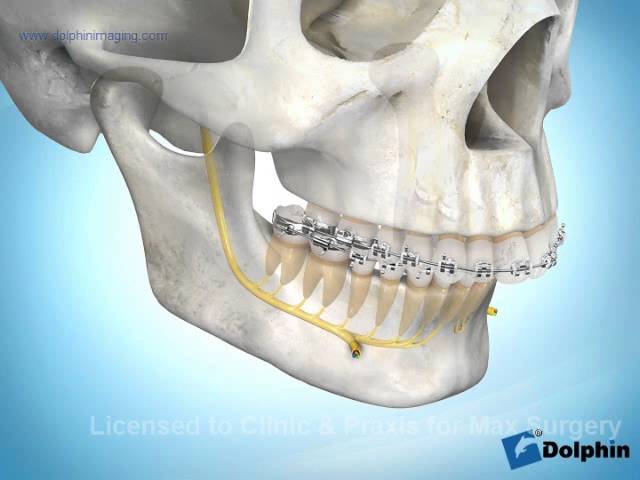
Beispiel der chirurgischen Behandlung einer Schlaf-Apnoe durch Kiefervorverlagerung und ante clockwise rotation (Englisch folgt)
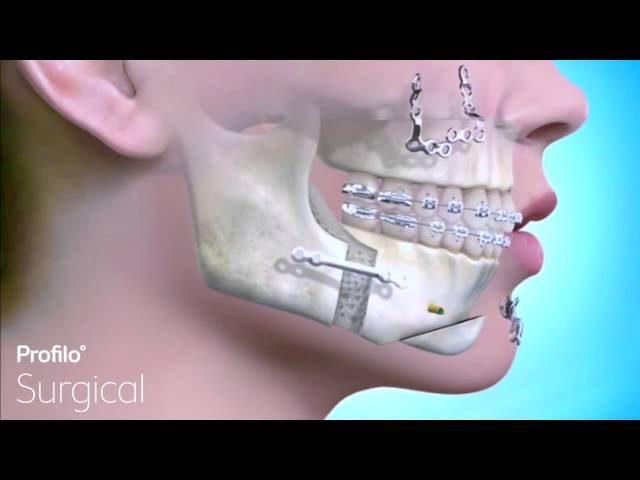
Beispiel der chirurgischen Behandlung eines front offenen Bisses durch Oberkieferverlagerung und clockwise rotation (Englisch folgt)
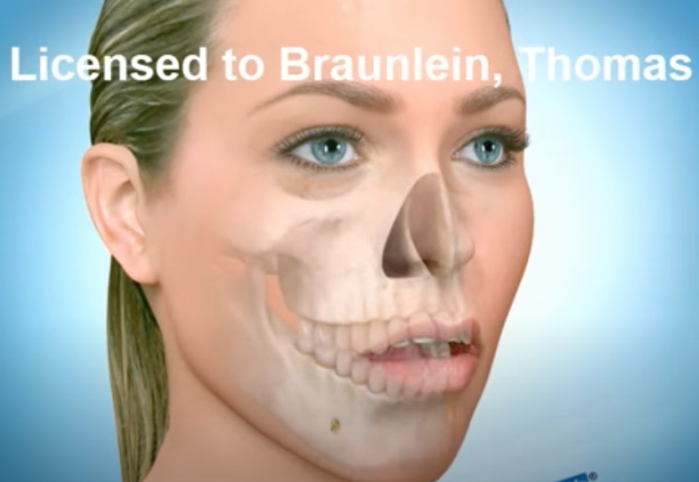
Snoring can also be attributed to a malformed jaw in some patients. For stronger jaw malpositions, the lip closure may be difficult. This results in an increased mouth breathing, which may lead to an increased susceptibility to caries diseases. Tooth decay is also more commonly seen in crowding of teeth, since the plastering situation is difficult.
Therefore, it is important to have a detailed history of the symptoms and a thorough examination in order to correctly assess the cause and treatment options of the jaw malformation. The severity of jaw misalignment may vary and thus cause many different disorders.
Dysgnathia may produce dental stress and premature loss of teeth. Moreover, chronic overworking of the temporomandibular joint (TMJ) may create a symptom complex that may include slight TMJ pain, clicking or popping jaws or even severe headache and back pain.
Many people with a receding upper jaw suffer from extreme snoring or even sleep apnoea. If jaw misalignment is significant, lip occlusion may be impaired. This will aggravate mouth breathing and increase susceptibility to dental caries. Caries is also a frequent consequence of dental crowding because crowding may prevent thorough cleaning of the teeth. Severe jaw misalignment may even make it difficult for patients to speak, bite and chew properly.
Moreover, the position of the jaws has a substantial impact on our facial profile and on how we are perceived by others. A protruding chin, for instance, is considered a masculine feature, while a receding lower jaw is thought to make the face more feminine. This is why it is crucial to thoroughly investigate the causes of jaw misalignment in order to determine the most appropriate treatment of its symptoms. In general, specialists from various medical disciplines will jointly assess your specific case and co-operate throughout the entire treatment.
1) Joint development of a treatment plan by the orthodontist and maxillofacial surgeon
2) Pre-surgical orthodontics
3) Surgery
4) Post-surgical orthodontics/fine-tuning
5) Removal of the titanium plates used for stabilization, if necessary
In close co-operation with orthodontists, who will form of your dental arches, we will develop a treatment plan designed to realign the jaw relationship and achieve both functional and aesthetic improvements. The surgery will not only restore normal occlusion to improve masticatory function, but also optimize your facial profile. Corrective jaw surgery is conducted on a regular basis at our clinic.
Jaw fixation in the desired position is performed by means of
biocompatible titanium plates or a special orthodontic device (in case of jaw expansion).
Depending on the type of operation performed, the length of stay is about 3 to 7 day
The operation is performed under general anesthesia from the oral cavity at the highest medical level so that no scars are visible after the operation (minimally invasive). After the mobilization of the jawbone (osteotomy), the jaws can be moved into all spatial dimensions and guided into the previously planned situation. The upper jaw is mobilized for this in the LeFort I level, the lower jaw by a so-called sagittal cleavage. In order to achieve an optimal result, it is often necessary to operate both the upper and the lower jaw. The fixation of the jaw takes place in the intended position using biocompatible titanium plates
In some cases, the cause of a jaw deformity is in a too narrow upper jaw. In order to enlarge the upper jaw, it must first be prepared by surgery and then extended with a special orthodontic appliance. This procedure is called surgical palatal dilatation (GNE)
Where necessary, the metal plates or devices used for fixation are removed surgically after 9 to 12 months when a bony consolidation of the jaws in the new position has taken place. This operation can be carried out on an outpatient basis or during a short inpatient stay
When you are discharged from our clinic you will need to see your orthodontist immediately, who will continue to fine-tune your bite. Adjuvant physiotherapy may also necessary.
Please do not hesitate to contact us for a personal consultation. Your orthodontist would, of course, we welcome to join us.


